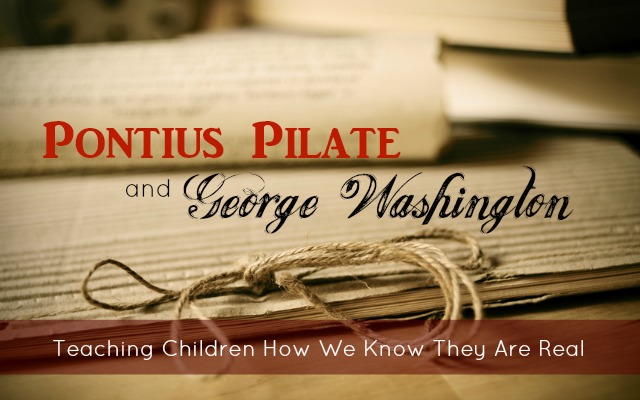Pontius Pilate and George Washington


For millennia, the Bible was read and taught by Christians as a historical book. Before then, the Jews held the Torah as not only sacred, but their own historical narrative, questioning the historical record and figures of Adam, Noah, Job and Abraham no more than Americans question our history of John Adams, Nathaniel Green, James Madison, and George Washington. Speaking of which, how do we even know these figures existed? How can we trust any historical report as true? More importantly, how can we teach it to our children, so they will be equipped with tools to know the truth about the past?
There is a way. Take George Washington. Famously known as our first president at the age of 57, a war hero who’d previously led the fledgling nation to victory against the British army in 1781, the architect of Mount Vernon and a man who was so esteemed and honored around the world that 60 British warships lowered their flags to half-mast at his death. Now, how do I know all this? I didn’t hear his inaugural address, read the peace treaty he signed or see that old Union Jack fly at half-mast in his honor. Of all those facts, Mount Vernon is the only one I can observe with my own eyes, and even there, I never saw the General oversee it (by the way, how do I know he was really a general?).
Verifying past events is known as historical science, because we can’t test our hypothesis in a lab. Thus, we rely on two tools: historical documents (which include eyewitness accounts) and physical evidence. The same would be true if I was a detective, seeking to solve a robbery mystery; I did not see it, but because truth leaves evidence, I can reconstruct what happened, and who was there, based on who saw it happen and the physical evidence left behind.
The same is true when teaching our children about historical figures recorded in Scripture. Too many times, we approach the Bible as if it were Aesop’s Fables, rather than God’s historical record and commentary on human history. For example, how do we know Pontius Pilate was, indeed, a verified historical person? Do we have historical documents, eyewitness accounts, and physical evidence for his existence? Yes, we do! All four gospels record his verdict on Jesus Christ, including verbatim quotes from his mouth. The Roman historian, Tacitus, also writes of him, as does the Jewish historian, Josephus. Part of the physical evidence is the “Pilate Stone,” a fragment of limestone, discovered in 1961, with the inscription recording Pilate’s name and governorship of Judea.
In teaching children history, teaching them why we can believe both biblical and American history is true is a great honor and joy. We need not – as teachers or students – be at the mercy of a historian’s opinion, but have tools available to us to uncover the truth for ourselves.
Kenzi Knapp is a follower of Christ, homeschool graduate and student of history. A fourth generation Missourian she enjoys writing about daily life enrolled in Gods great course of faith and His story throughout the ages at her blog, Honey Rock Hills.










































